

|
|
|
|
|
Legislative Commission on Solid Waste Management
April 2002

|
||||
| ||||
|
Assemblyman William Colton, Chair Legislative Commission on Solid Waste Management April 2002 |
||||
|
|
|
|
|
|
|
|
|
Municipal Solid Waste Management 2000 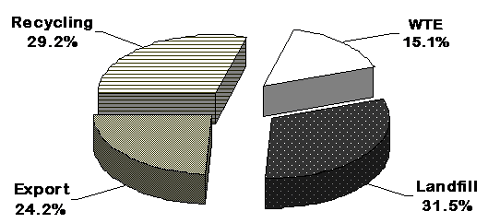
|
|
|
1Some of the increase in recycling can be
attributed to the inclusion, for the first time in the Commissionís data
compilation, of some of the commercial recycling in New York City
(approximately 420,000 tons). 2This yearís report excludes waste that was disposed at five landfills since 1996, which was included in previous reports. These facilities used to be primarily MSW landfills but since 1995 disposed primarily non-MSW wastes including clean fill, construction & demolition debris, and MSW ash (raw MSW has been prohibited from landfill disposal on Long Island pursuant to the Long Island Landfill Law). The tonnages at these landfills totaled slightly under one million tons per year. 3Much of the landfill decrease and export increase in 2000 can be attributed to the inception during 1999 & 2000 of additional contracts by NYC for increased portions of the Cityís Department of Sanitation-collected residential waste to be diverted from disposal at Fresh Kills landfill to facilities outside of the City. Waste disposed at Fresh Kills was 900,000 tons less in 2000 than in 1999. |
|
|
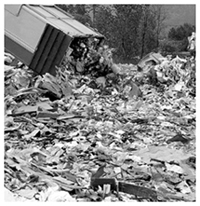
|
Waste Management Summary 1990-2000 in thousands of tons (percentage of yearís total waste in parentheses) |
| Option | 1990 | 1991 | 1992 | 1993 | 1994 | 1995 |
| Recycling | 1,070 (5.6) | 1,635 (8.2) | 2,072 (10.3) | 2,975 (14.8) | 3,189 (15.8) | 4,432 (21.2) |
| WTE | 2,942 (15.5) | 3,096 (15.6) | 3,371 (16.7) | 3,421 (17.0) | 3,386 (16.8) | 3,542 (16.9) |
| Incineration | 891(4.7) | 969 (4.9) | 880 (4.4) | 500 (2.5) | 29 (0.1) | 0 |
| Landfill | 10,951(57.5) | 10,438 (52.4) | 9,958 (49.4) | 9,358 (46.4) | 9,431 (46.8) | 9,085 (43.5) |
| Export | 3,181 (16.7) | 3,774 (19.0) | 3,874 (19.2) | 3,907 (19.4) | 4,119 (20.4) | 3,849 (18.4) |
| Total | 19,035 (100) | 19,912 (100) | 20,156 (100) | 20,160 (100) | 20,154 (100) | 20,908 (100) |
| Option | 1996 | 1997 | 1998 | 1999 | 2000 | % change 1999-2000 |
| Recycling | 4,591 (22.5) | 5,087 (25.1) | 5,238 (24.7) | 5,903 (25.9) | 7,0171 (29.2) | + 18.9 |
| WTE | 3,668 (18.0) | 3,677 (18.1) | 3,670 (17.3) | 3,680 (16.1) | 3,638 (15.1) | - 1.1 |
| Landfill | 8,6222 (42.3) | 7,7852 (38.4) | 7,9622 (37.5) | 8,1272 (35.6) | 7,5722,3 (31.5) | - 8.1 |
| Export | 3,505 (17.2) | 3,717 (18.3) | 4,346 (20.5) | 5,095 (22.3) | 5,8043 (24.2) | +13.9 |
| Total | 20,386 (100) | 20,266 (100) | 21,218 (100) | 22,805 (100) | 24,031 (100) | + 5.4 |
This table shows the yearly tons managed by various waste management alternatives and totals from 1990 through 2000. The last column shows percentage changes in those tonnages from 1999 to 2000. The total tons of waste identified have risen from 19 million in 1990 to 24 million in 2000 (28% increase). |
||||||
|
|
|
Waste Management
Comparison
1990-2000 |
 |
|
Municipal Recycling
in New York State, 1990-2000 |
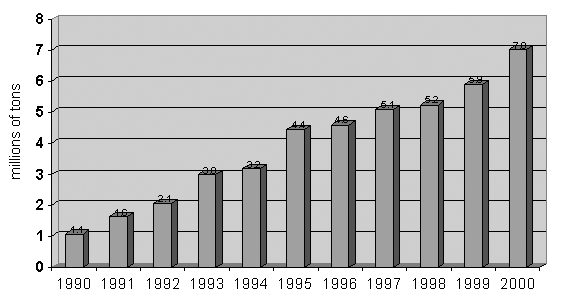 |
|
|
|
Waste-to-Energy
in New York State, 1990-2000 |
 |
|
|||
| Facility Name | County | Owner Type | |
|
Hempstead RRF Islip RRF Babylon RRF Huntington RRF Dutchess Co. RRA Charles Point RRF Adirondack RRF Onondaga Co. RRA Oswego Co. American Ref-Fuel -Niagara Falls |
Nassau Suffolk Suffolk Suffolk Dutchess Westchester Washington/Warren Onondaga Oswego Niagara |
Private Municipal Municipal Municipal County County County County County Private |
|
|
|
|
Disposal in Sanitary Landfills
in New York State, 1990-2000 |
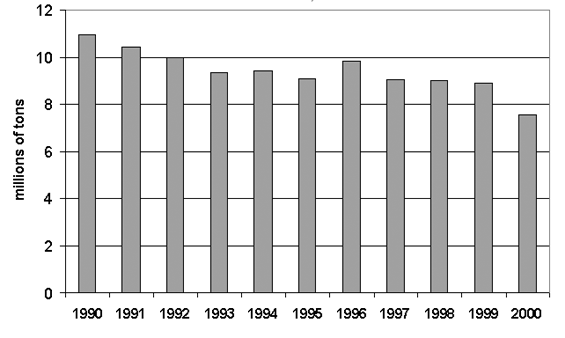 |
|
Out-of-State Disposal
1990-2000 |
 |
|
|
|
Number of Sanitary Landfills by Yearly Tonnages
1988 & 2000 |
|||||||||||||||||||||||||||||||||||||||||
|
|||||||||||||||||||||||||||||||||||||||||
|
* The 28 landfills operating at the end of 2000 are listed in the box below.
Shown in this table is the number of active landfills in New York State in 1988 and 2000 by annual intake with a breakdown between public and private ownership of the facilities. The number of operating sanitary landfills was 86.4% lower in 2000 than it was in 1988, but nearly the entire decline from 206 to the current 28 occurred by 1997, when the number had fallen to 30 (not shown here). Nearly all of the landfills closed since 1988 (as well as prior to that) were small municipal landfills, primarily town dumps. |
|||||||||||||||||||||||||||||||||||||||||
|
|||||||||
|
Fresh Kills Al Turi Sullivan County Greater Albany Colonie Town Delaware County Schuyler Falls Franklin County Fulton County Development Authority of the North Country Broome County Auburn City Chenango County Cortland County Madison County Bristol Hill Chemung County Mill Seat High Acres Western Expansion Ontario County Seneca Meadows Steuben County Allegany County Hyland Ellery CID Modern Niagara Recycling |
Richmond Orange Sullivan Albany Albany Delaware Clinton Franklin Fulton Jefferson Broome Cayuga Chenango Cortland Madison Oswego Chemung Monroe Monroe Ontario Seneca Steuben Allegany Allegany Chautauqua Erie Niagara Niagara |
Municipal Private County Municipal Municipal County County County County County County Municipal County County County County County County Private County Private County County Private County Private Private Private |
|||||||
|
|
|
Solid Waste Management in New York State
by DEC Region in 2000 (in thousands of tons) |
||||||||||||||||||||||||||||||||||||||||||||||||||||||||||||||||||
|
||||||||||||||||||||||||||||||||||||||||||||||||||||||||||||||||||
|
The above table summarizes how waste was managed in each DEC region during 2000. Recycling tons are as reported by the counties (or planning units) of the region. Waste shown as landfilled or burned represents all that was disposed at facilities in a region. The waste export category refers to waste generated in the region which was sent out-of-state. |
|
SOLID WASTE MANAGEMENT
PLANNING UNITS by DEC Region |
||
|
Region 1 Town of Babylon Town of Brookhaven Town of East Hampton City of Glen Cove Town of Hempstead Town of Huntington Town of Islip City of Long Beach Town of North Hempstead Town of Oyster Bay Town of Riverhead Town of Shelter Island Town of Smithtown Town of Sounthampton Town of Southold Fishersí Island Region 2 New York City Region 3 Dutchess County RRA Orange County Putnam County Rockland County SWMA Sullivan County Ulster County RRA Westchester County |
Region 4 ANSWERS Town of Colonie Columbia County Delaware County Greene County Montgomery, Otsego, Schoharie SWMA Eastern Rensselaer County SWMA Greater Troy SWMA Schenectady County Region 5 Clinton County Essex County Franklin County Fulton County Hamilton County Saratoga County Washington/Warren Counties Region 6 Jefferson County Lewis County Oneida-Herkimer SWMA St. Lawrence County |
Region 7 Broome County Cayuga County Chenango County Cortland County Madison County Onondaga County Oswego County Tioga County Tompkins County Region 8 Chemung County Genesee, Livingston, Orleans, Wyoming Counties (GLOW) Monroe County Schuyler County Steuben County Western Finger Lakes SWMA Region 9 Alllegany County Cattaraugus County Chautauqua County Erie County Northwest Communities of Erie County Niagara County |
|
|
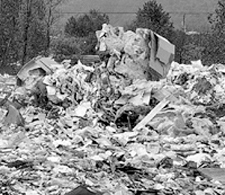
|
MUNICIPAL SOLID WASTE MANAGEMENT FINANCIAL ASSISTANCE | ||
|
|||
|
|
| FLOW OF MUNICIPAL SOLID WASTE | |

The 1994 U.S. Supreme Court decision in the Carbone case overturned flow control laws that directed MSW to designated facilities. That decision led an increased number of haulers to shop around for the best disposal arrangement. This often impaired municipalities and solid waste authorities that relied on the guaranteed tonnage provided by flow control to finance new disposal and recycling facilities in the 1980ís and early 1990ís. Efforts to blunt the impact of the Courtís decision were successful in a few areas, most notably Smithtown and Babylon on Long Island where waste collection districts were instituted creating "contractual" or "economic" flow control arrangements. These systems, however, have not proven workable for many municipalities and solid waste authorities that formerly relied on flow control. Many have since had to subsidize their operations so that lowered tip fees would attract haulers. A recent U.S. Second Circuit Court of Appeals decision, however, validated the means by which many municipalities initially instituted flow control. In July 2001, the case was decided in favor of Oneida-Herkimer Solid Waste Management Authority stating that flow control ordinances like Oneida-Herkimerís are allowable because they direct waste to publicly-owned facilities. Since then, the U.S. Supreme Court denied the petition to appeal, meaning that the Second Circuit Courtís decision stands. |
|
|
|
|
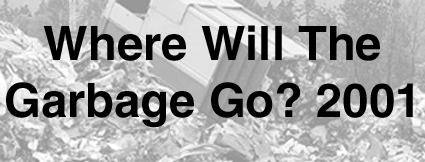
|
|
Legislative Commission on Solid Waste Management 4 Empire State Plaza, 5th Floor, Albany, NY 12248 Patrick Golden, Principal Author In order to reduce waste, if you have a change in address, please inform the commission by mail, phone, or fax:  Assemblyman William Colton, Chair
Assemblyman William Colton, ChairLCSWM 4 Empire State Plaza, 5th Floor Albany, NY 12248 (518) 455-3711 (518) 455-3837 (fax) |

|
|
New York State Assembly [ Home Page ] [ Committees ] |